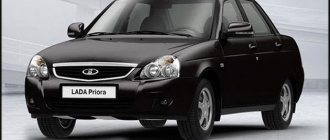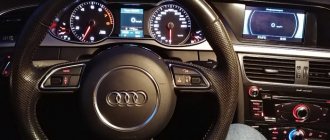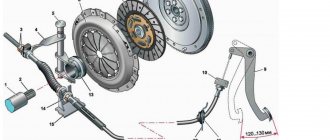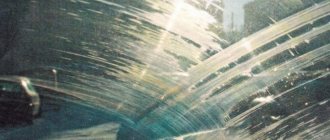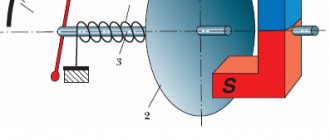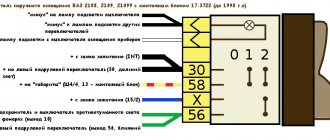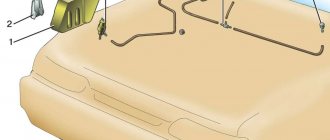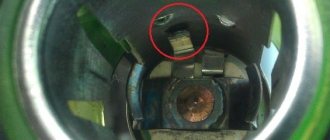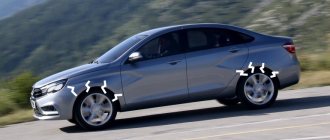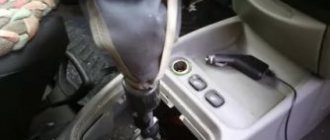Car radio with USB input
Most modern car radios have a USB input for reading audio files from a flash drive. This method of storing and reproducing audio information is more reliable, noise-resistant, informative and convenient from a consumer point of view than CDs and DVDs.
Many manufacturers are gradually abandoning disk drives in favor of USB and other electronic storage media.
However, the playback method via a USB port has one fundamental drawback: some flash drives and various car radios refuse to be read. Moreover, a situation very often occurs when one radio tape recorder reads the same flash drive without problems, but the other completely refuses to “see” it.
Trouble with formats
Almost all modern radios are equipped with USB outputs for connecting portable devices:
- The main devices, of course, are USB Flash or, popularly, “flash drives,” on which today it is very convenient to store music and then play it in the car
- In addition, today you can connect an MP3 player, phone or portable hard drive via USB, and 50% of car radios will also read these devices
- Why only 50%, because, as a rule, the radio is designed exclusively for FLASH, a hard drive, or a phone may simply not be detected
- It’s convenient, you download music through the “computer” and in just a couple of minutes you listen to it in your car
- Got tired of it, erased the old recordings with my own hands and immediately recorded new tracks, no need for any discs, which then gather dust in bundles
- However, sometimes problems arise, the “flash drive” in the radio is not readable, although everything was fine on the computer
- This happens, but it does not always mean that your “carrier” is broken
- The most common option is too much flash memory
- Typically, the manufacturer itself provides instructions for the radio, which indicate the maximum volume of media that your radio can recognize and play.
- Typically, the maximum volume is 4 Gigabytes, for outdated options it can be 3 Gigabytes
- And if you insert 8-16 gigabytes, then the radio simply does not perceive it
- Accordingly, this flash drive will not be read
- The second option is the wrong file system of the flash drive.
- The format of a flash drive for a car radio is FAT32. Modern high-speed flash drives have other file systems, for example, NTFS, so it will not be readable
- Here you need to look at the file system on your computer
- To do this, simply insert the flash drive and right-click - then select properties and look for an item called “file system”, it should be FAT32
- If you have a different one, no problem, just below we’ll look at how to reformat a flash drive
- If the flash drive has the correct system and file format, and yesterday the music played without problems, but today it doesn’t, this also happens
- Moreover, when you insert a “flash drive” into your computer, it sees everything and plays the files, but the car’s radio refuses to play music
- It's simple, errors could have accumulated in the flash drive itself
- You just need to format it, I’ll tell you in detail how to do this below.
Attention: After formatting, all data will be lost, so if possible, copy it to your computer
- When your “Flash Drive” is not readable both in your car and in your computer, but is recognized by the computer as a removable disk
- There is only one solution - format
- However, the files will no longer be saved, you will no longer be able to rewrite them - because the flash drive is unreadable
- Music is not a big loss, you can re-upload it from your computer or download it from the Internet
- When the device is not readable either in the car or on the computer
- The computer usually writes - device detected is not recognized, the problem repeats on different computers (it’s better to check on at least three)
- It looks like the flash drive is dead, all you can do is buy a new one, it cannot be repaired
- If suddenly on any computer it is suddenly recognized as a removable disk, read on
- The cause of the breakdown is either a defect, or this is the price of the issue for careless handling, before removing the flash drive from the radio, it is better to turn off the radio itself, the same thing when turning it on
- On the computer, first select the option to safely disconnect the device, then you can remove the flash drive, otherwise there is a possibility of damage to it
- I don’t even want to argue, you don’t need to prove to me that you took it out and put it in a thousand times, without following the described measures, and everything was fine - the thousand first time it may not work
Why doesn't the radio read the flash drive in the car?
The main reasons that the car radio does not see the USB flash drive are:
1. Lack of file system support for the car radio
, in which the flash drive is formatted.
Most car radios produced before 2010 support FAT32 USB file systems. If the radio is even older, then it can only support the FAT16 file system.
New car radios, especially standard ones, may have support for the NTFS file system, and if the media is formatted in FAT32, which is more “ancient” from their point of view, problems may arise when reading audio information.
If there is no reliable information on the radio (technical characteristics) about what file system the USB port driver supports, in many cases you have to sequentially reformat the flash drive to FAT32, then to NTFS, respectively, write test audio files to it.
This can only be done using a computer (laptop, netbook). To do this, right-click on a removable disk (flash drive) connected to the computer, select “formatting” in the context menu
and then the corresponding file system.
2. Inability to read audio files stored in folders with a complex hierarchy
. Car radios produced before 2000 and inexpensive FM transmitters suffer from this disease.
If the playlist has subfolders, for example, such as root directory - Russian songs - folk - babkina, then perhaps it will not be possible to enter some folders remote from the root directory.
Therefore, on radios made before 2000, it is better to record audio files in the root directory, especially since using a computer it is not difficult to create and rewrite any playlist.
3. Exceeding flash storage capacity requirements
. Over time, the capacity of USB storage devices is rapidly increasing. Flash drives up to 8 GB, as a rule, are read by all car radios. Regarding the installation of higher-capacity media, you should check how much capacity, inclusive, is supported by the radio installed in your car.
4. Incorrect (most likely Russified) names of audio files
and folders. At best, what most non-Russian radio tape recorders do is to write the names of audio files in the form of Russian hieroglyphs, at worst, they refuse to read them.
Video - why the flash drive does not work in the car and how to format it:
If folder names are written in Russian, access to these folders may be denied. In any case, if a non-Russian radio model is installed in the car, it is better to rename the files and folders to English characters when creating a playlist on a flash drive.
5. Inability to read audio files recorded in other formats
associated with the lack of appropriate codecs. Many audio files can have different origins: downloaded from the Internet, recorded from a DVD, sent by friends. Therefore, their formats may differ.
Each car radio has a set of codecs that determine the types of audio files that can be played. When buying a radio, you need to pay attention to this fact. As a rule, the standard set includes the most common mp3 and wav formats. Good radios support most known formats.
But, if you inherited an old radio tape recorder, and the recording has musical value, it can always be re-encoded using special converter programs on your computer.
6. Radio software crashes
, often found in multimedia complexes with an Internet connection in case of virus infection. Nowadays, it is not uncommon for even radios connected to the Internet to start mining. At the same time, its resources are limited to almost zero. Even the usual codecs are not fast enough, and the audio file slows down or does not play at all. The same effect can be obtained by catching some kind of virus, even from a music flash drive.
Advice: check flash drives for viruses (at least with a simple antivirus program) before installing it in the radio.
7. Technical difficulites
(damage to the USB connector, driver, problems with the power bus). Such problems often occur when they try to use the USB connector of the radio to charge car gadgets.
Remember: in most car radios, a USB connector is provided only for installing a working flash drive (unless an additional purpose is specified in the technical specifications of the radio).
8. In car radios (or flash drives) of dubious origin there is another reason - “ for no reason at all.”
" Flash drives on which information is recorded in completely identical formats with the same file system and volume, one is readable, the other is not. In this case, you have to individually select flash drives for the radio, and nothing can be done.
Failure to read the flash drive by the radio due to poor contact in the connector
Quite often, the radio tape recorder stops reading the flash drive due to poor contact or its absence with the audio system connector. The seat for the USB flash drive is damaged due to frequent connection and disconnection of the drive. It is quite simple to eliminate such a defect using a soldering iron and a spare connector; let’s look at how such work is done using the example of a JVC car radio:
- Unscrew the screws on the back side of the removable panel;
- We separate the halves of the plastic case and remove the board (it is secured with latches). It is important during disassembly not to lose the spring for tilting the panel;
- Use a soldering iron to solder the old connector and install a new socket instead;
- install the board into the case and assemble the panel.
If during disassembly we find that there is poor soldering on the contacts, before changing the plug, we first try to solder it. It may happen that replacing the socket is not required, only soldering will be enough.
Related articles:
- Do-it-yourself vulcanization - repair features, advantages and disadvantages With the modern development of the car service network, many car owners prefer to entrust minor repairs and maintenance of their car to professionals: the work is relatively inexpensive, […]
- Heating the windshield with your own hands A frozen windshield in winter is a big problem, since good visibility is needed to move a car. Removing ice crust from glass takes a lot of time, so in the morning [...]
- Changing the valve timing in the engine The valve timing is of great importance in the engine, and the efficiency of the internal combustion engine, its throttle response, stability at idle […]
How to decipher the error code and fix it
Some “smart” car radios report information on the display that they specifically do not like about the USB storage device.
For example, these error codes:
- ERROR 23 – FAT32 or NTFS file system mismatch;
- ERROR-PROTECT – absence of Windows Media codec in the radio;
- CHECK USB – USB port power supply error;
- ERROR 19 – Cyrillic in file names, complex hierarchy, lack of an appropriate codec, etc.
For other types and error codes, please refer to the owner's manual for your specific brand of car stereo.

